 |
|

|
 |
TABLE of CONTENTS
 |
Interstate 494 project in Plymouth is complete |
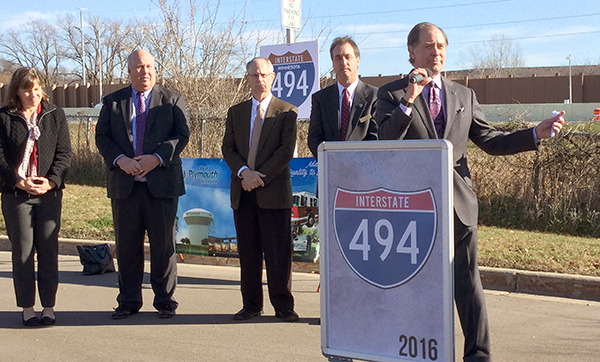
Commissioner Charlie Zelle spoke during the Interstate 494 ribbon cutting ceremony Nov. 16 in Plymouth. Also attending the event were (from left) Katie Rodriguez, Met Council; Mark Steffenson, Maple Grove mayor; Terry Schneider, Minnetonka mayor, and Dave Callister, Plymouth city manager. The three-year project added a lane in each direction, replaced bridges and did maintenance repairs on several ramps. Photo by Kevin Gutknecht |
|
 |
|

|
 |
TABLE of CONTENTS
 |
Sharing the pavement: Partner states get first look at their Minnesota road experiment |
By Shannon Fiecke, Research Services
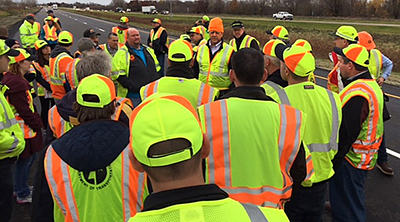
Dave Van Deusen at center, research operations engineer, gave other state DOT engineers a tour of new pavement test sections at the MnROAD research facility and at an off-site location in rural Mille Lacs County. Photo courtesy of Randy West, National Center for Asphalt Technology |
Walking along a half-mile segment of Co. Rd. 8 near Milaca last month, materials engineers from around the country got a first look at a shared test site for pavement preservation.
Nearly 60 one-tenth mile sections of Co. Rd. 8 and nearby Hwy 169 were recently treated with various combinations of fog seals, chip seals, crack seals, scrub seals and microsurfacing and a number of thin overlays. Data will be collected from these experimental test roads for three years and compared with the results of a similar experiment in Alabama, where the same test sections were also built on a low- and high-volume roadway, to see which techniques are the most effective for preserving road life.
“Evaluating pavement performance in both northern and southern climates will provide cost-effective solutions that can be implemented nationwide,” said Ben Worel, MnROAD operations engineer.
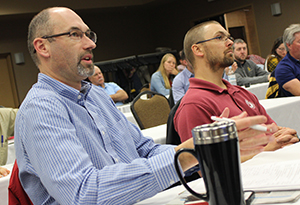
From left, Barry Paye, Wisconsin DOT chief materials engineer, and Tim Clyne, MnDOT Metro District materials engineer, participate in a discussion about future road research needs. Photo by Shannon Fiecke |
Nineteen states, which are co-funding the study through MnDOT’s road research facility (MnROAD), were in town Oct. 26-27 for a joint meeting with the National Center for Asphalt Technology in Auburn, Ala. In addition to touring test sections built this summer near Milaca and at MnROAD’s permanent test track in Albertville, the group reviewed preliminary research results and discussed ideas for new experiments.
MnROAD began two joint research efforts with NCAT last year to advance pavement engineering issues that affect both warm and cold climates. In addition to determining the life-extending benefits of different pavement preservation techniques, the partnership has also built test cells to evaluate which asphalt cracking prediction tests best predict future pavement performance. This second study will help state DOTs improve the quality of asphalt mixes, so roads hold up better through harsh winters, leading to less thermal cracking and fewer potholes.
Click here to learn more about the MnROAD-NCAT partnership. |
 |
|

|
 |
TABLE of CONTENTS
 |
Office of Maintenance employee eligible for vacation donation |

Curt Pape, Office of Maintenance, was diagnosed with chronic systolic heart failure and is eligible for the vacation donation program. Photo by Joe Huneke |
Curt Pape, transportation program supervisor senior in the Office of Maintenance, is eligible for the state vacation donation program. Pape has worked for the department for 29 years.
After having been diagnosed with chronic systolic heart failure, a progressive life-threatening illness that needs to be managed carefully, he is unable to work.
Pape has exhausted all of his sick and vacation leave.
To donate vacation hours, go to the Employee Self Service Web site and click “Other Payroll” and then “Leave Donations.” Click on the magnifying glass next to “Reserve Bank” to open a list of names and select his name.
The paper form is also available online.
The site also lists all state employees eligible for the program and provides instructions to enroll as a recipient. |
 |
|

|
 |
TABLE of CONTENTS
 |
WIG 2.0 highlight: External Customer Engagement focus area seeks to involve customers, improve experience |
By Judy Jacobs
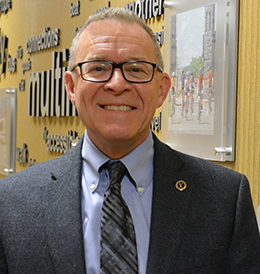
Scott McBride, Metro District engineer, serves as champion for the WIG 2.0 Earning Customer Trust Focus Area of external customer engagement. Photo by Judy Jacobs |
More than 550 WIG 2.0 teams across the state are working on sub-WIGs to help the agency earn customer trust. Of those teams, 157 are working on the focus area of “Improve External Customer Engagement.” Customer engagement is defined as “an effect, a reaction, a connection, a response and/or an experience of customers” with an organization.
The External Customer Engagement Focus Area includes three goals:
- Improve Customer Involvement - The extent to which MnDOT involves, engages and responds to its customers and stakeholders to ensure they are part of the process. Champion: Chris Roy
- Consider Customer Impact – How MnDOT actions affect customers and stakeholders. Champion: Amr Jabr
- Improve Customer Experience – The quality of the experience the customer or stakeholder had during their involvement with MnDOT. Champion: Richard Davis
“The vision for this focus area is to stay in sync with our external customers, by not only engaging them, but also continually asking them how we are doing at delivering our products and services,” said Scott McBride, Metro District engineer and champion for this focus area. “That allows us to continue to be as flexible as we can with changes coming our way.”
One of State Aid for Local Transportation’s WIG teams is focusing on streamlining the process for locally initiated cooperative agreement projects.
“We hear our local agency customers say this process is too costly and time consuming,” said Greg Coughlin, State Aid projects manager. “Over time the process requirements have grown and now we’re looking for opportunities to adjust and redesign the process.”
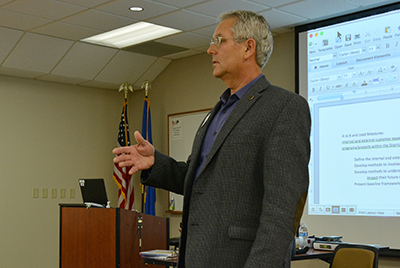
Greg Coughlin presenting the SALT team sub-WIG at the recent Customer Centered Culture training at Arden Hills. Photo by Judy Jacobs |
The SALT WIG team’s A to B statement, “Establish a clearly defined and customer-focused locally initiated cooperative agreement program/projects vision by June 30, 2017,” is largely about improving local agency customer experiences when delivering a cooperative agreement project. However, as its first lead measure, the WIG team identified three sets of customers--their internal customers consisting of MnDOT districts and Central Office offices, and their external audience of local agency customers across the state.
Next steps will be to develop methods to involve all customers by capturing their feedback and then creating ways to understand customer desired outcomes and what changes will most positively affect their future experiences.
“There is a challenge of communication from the very beginning of the process,” Coughlin said. “We are actively looking at ways to improve that.”
A survey is underway with internal and external customers to get a baseline (general rating) of customer experiences. The survey links are at the bottom of every employee email after the signature block.
The Senior Leadership Team and WIG 2.0 champions will determine and prioritize additional survey phases based on the results.
“Ultimately the External Customer Engagement Focus Area is aimed squarely at our WIG’s main outcome of earning our customers’ trust and increasing transparency by directly engaging our customers and listening to understand and respond to their needs,” McBride said. |
 |
|

|
 |
TABLE of CONTENTS
 |
Email clean-up week set for Nov. 28 to Dec. 2 |
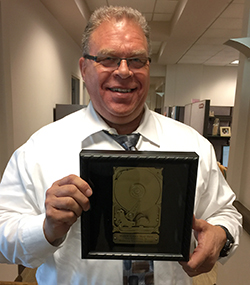
Kevin Gutknecht, Office of Communications director, holds the Golden Hard Drive. His office won the traveling trophy in May during the spring data storage clean-up week. Photo by Rich Kemp |
MnDOT offices and districts will have the opportunity for another friendly intra-agency clean-up competition the week of Nov. 28-Dec. 2 when employees are challenged to reduce their email files and ensure the proper retention of records.
Call it the Great Electronic Clean-up Challenge, Fall Edition.
Last spring, in a similar competition, MnDOT employees were asked to devote four hours over a one-week period to reduce the amount of electronic documents stored on their hard drives.
This time around, the focus is on emails. Employees again will be asked to dedicate four hours during clean-up week to review their emails and delete outdated non-record (redundant, obsolete or trivial) emails or delete record emails that have reached the end of their retention period.
The office or district that reduces its email storage by the highest percentage will win the traveling “MnDOT Golden Hard Drive” trophy. The Golden Hard Drive currently resides in the Office of Communications, which won the spring competition.
What is a record? Any recorded information, regardless of medium or characteristics, made or received by an organization that is evidence of its operations, and has value, requiring its retention for a specific period of time. See the Records Management website for more information.
Additional information and instructions will be coming soon via NoteMailer.
|
 |
|

|
 |
TABLE of CONTENTS
 |
On the Job: Inyan Walking Elk moves into Employee Resource Group rotation |
By Rich Kemp
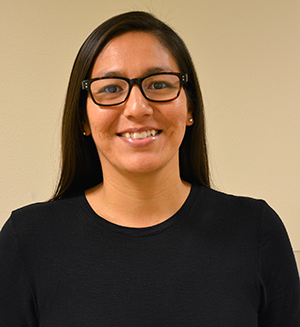
As part of her new mobility assignment, Inyan Walking Elk will serve as a paralegal for discrimination and ADA cases for the Office of Equity and Diversity. Photo by Rich Kemp |
Inyan Walking Elk is taking on a new challenge. She is moving into a new role in the Employee Resource Group Rotation Program. The new program began in July and has got off to a fast start with four employees already in the program.
“The program is a partnership between the Office of Equity and Diversity and the Office of Human Resources,” said Verona Mitchell, program coordinator. “The program is flexible. It is designed to accommodate the differing needs of host offices and participants.”
It provides ERG members, allies and Leadership Development Program participants the opportunity to gain career experience, through a formal rotation/job mobility, that prepares them for leadership opportunities within MnDOT.
Walking Elk's new assignment is serving as a paralegal for discrimination and Americans with Disabilities Act cases for the Office of Equity and Diversity. She has become accustomed to challenges. She has worked in a variety of roles at MnDOT for five years and was the chair of the Indigenous Employee Resource Group for the last four years.
Before joining the Office of Equity and Diversity, Walking Elk worked in the Office of Construction and Innovative Contracting as the work zone safety awareness program coordinator.
Why were you interested in the ERG Rotation Program?
I was interested because it is a flexible program and it gives you the opportunity to develop the skills of your choosing as long as they align with the office. I am able to use my skills as a paralegal and do legal research, which is exciting for me. The program also helps with retention and keeping good people at MnDOT and helps encourage upward mobility within the organization.
What is a typical day like?
I assist case managers and do a lot of research on cases. I assist the office with training research, verifying information, finding new information and updating curriculum. I do a little more traveling with trainings and investigations than I did in my previous position, but I am mostly in the office.
What is the exciting part of your job?
I really liked my job with work zone safety, but the best part of this mobility is being able to develop my paralegal skills. The subject matter is very delicate and important that we respect confidentiality. I am enjoying learning about and assisting investigations.
What have been the biggest challenges?
The biggest challenge has been shifting from work zone safety, switching from contracting to the legal field. I have been reviewing legal information, which has been helpful in refreshing my memory.
You have been involved with the Indigenous Employee Resource Group. What has that been like?
My family background is from five different tribes. I grew up following the Lakota way and some Arapaho customs. I keep my children familiar with our life ways and still take my family to South Dakota for tribe events.
The IERG has been a great learning experience. We are a really small group, so making things happen was a challenge. We have developed a good team. It took a lot of teamwork to organize events to celebrate Native American Heritage month in November and American Indian Month in May. They are used as ways to educate employees about Indian customs and our history.
I encourage anyone who is interested in the ERG program to check it out. Allies are also important to the program. It is important to educate allies and have them share the information.
Other employees in the ERG rotation program include:
- Broderick Bell, community engagement officer, Re-thinking I-94 project
- John Tompkins, management team, West Metro District operations
- Hillary O’Belle, engineer, surveying and design at Metro District operations
For additional information on the ERG Rotation Program and the application process, check out the program website.
Do you or a co-worker have an interesting job to share with readers? Send us your ideas, and we’ll contact you for more information.
Recent employee profiles:
|
 |
|

|
 |
TABLE of CONTENTS
 |
District 2 employees help support safety of local law enforcement |
By TJ Melcher, District 2 public affairs coordinator
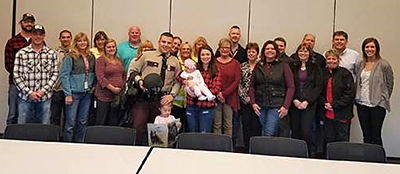
State Trooper Kyle Goodwin and his family pose with District 2 employees. The district employees raised funds to provide Goodwin with protective armor and gear to keep him safe on his job. Photo by TJ Melcher |
Each year employees across MnDOT band together in support of charitable endeavors, and for those in District 2, this year’s campaign is helping to protect those who have pledged to protect us.
“We generated more than $1,000 in donations,” said Joe McKinnon, who helped coordinate District 2 fundraising. “We held a donut day sales campaign, chili cook off, best hot dish challenge, recycled aluminum cans and sold popcorn. Since we reached our goal amount, it allowed us to fully sponsor Shield 616 Armor for a local law enforcement officer.”
Shield 616 is a non-profit organization with the two-fold goal to equip every officer with advanced protective armor and gear, and to provide an additional external support group that supports the officer and their family through encouragement and prayer.
“Currently our local officers wear Level III ballistic gear under their uniforms,” explained State Trooper Scott Mattfield. “It’s rated to stop a hand gun round, but is useless against a rifle or shotgun round.”
The Shield 616 gear is Level IV ballistic armor that can stop the more dangerous rounds and can be worn during advanced threatening circumstances, such as an active shooter situation. The gear is worth more than $2,400, but through the Shield 616 non-profit, a person, group, business or church can sponsor the full package for one officer at $1,000. Additionally, the gear is replaced every five years at no cost to the officer or department.
State Trooper Kyle Goodwin was one of four local troopers who expressed interest in a Shield 616 sponsorship, and on Oct. 26, he and his family met with district employees to receive his equipment.
“We’re humbled,” said Goodwin, referring to his family. “It’s a blessing to know that our community is willing to support us like this.”
Shield 616 derives its name from Ephesians 6:16. “Take up the shield of faith, with which you can extinguish all the flaming arrows of the evil one.” It is a nationwide initiative, but a local group was formed to support officers in the region. That group started with the goal of raising enough funds to outfit eight officers. Through the support of groups such as District 2 employees, 34 area police, sheriff and troopers received the advanced life-saving gear. |
 |
|

|
 |
TABLE of CONTENTS
 |
TZD puts safety messages on overhead electronic message signs |
By Sue Roe
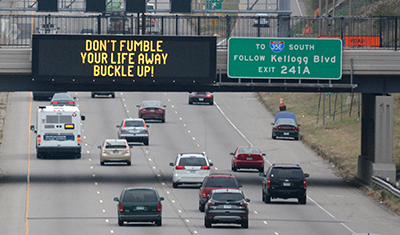
The electronic message sign in St. Paul alerted drivers, “Don’t fumble your life away. Buckle up!” It was part of a Message Monday campaign, which kicked off Nov. 14, to bring attention to safe driving. Photo by Rich Kemp |
MnDOT and the Department of Public Safety launched a new Message Monday campaign Nov. 14 using the state’s electronic message signs to bring attention to safe driving.
The signs, located above freeways and other high-traffic roads, already are used to display messages related to road conditions, speed limits, construction and DPS enforcement efforts. Message Monday will relay safety messages each week to start conversations that could positively change the state’s traffic culture.
“Since 2013, we have let motorists know that law enforcement was conducting extra enforcement for specific traffic behaviors, but now we are focusing on a second phase to change the culture around traffic safety in a more creative way,” said Kristine Hernandez, statewide Toward Zero Deaths program coordinator.
Crash data led Minnesota to model what Iowa and other states are doing to tell motorists about seat belt use and the risks of distracted driving, speeding, and drunken and aggressive behaviors.
“A reduction in fatalities and serious injuries will only occur if we use new and innovative ways to educate motorists on traffic safety risks,” said Jay Hietpas, state traffic engineer and co-chair of the TZD leadership committee. “We believe the signs have potential to change driver behavior while they are driving.”
A recent U.S. Department of Transportation report about the public’s perception of safety messaging showed that between 45 percent and 68 percent of travelers indicated that safety-related messages caused changes in their driving behavior.
Messages that could show up on the signs include “Driving drowsy could wreck the holidays,” “Friends don’t text friends who are driving,” and “Turn signals – the original instant message.”
The messages will focus on the emotional ties of traffic safety with an emphasis on positive messages that stimulate safe and acceptable rules of driving behavior. Creating a traffic safety culture to reduce fatalities and crashes is the mission of the Minnesota TZD program.
There are 180 dynamic message signs in the Twin Cities’ Metro area and 100 in Greater Minnesota. About half of the signs in the Twin Cities will display Monday Messages during the off-peak hours on Mondays between 9 a.m. and 3 p.m., and after 7 p.m. on roadways that have higher traffic. In other locations, the messages will be displayed between midnight and noon.
For more information on TZD go to www.minnesotatzd.org. |
 |
|

|
 |
TABLE of CONTENTS
 |
Tina Markeson works with high school biology students |
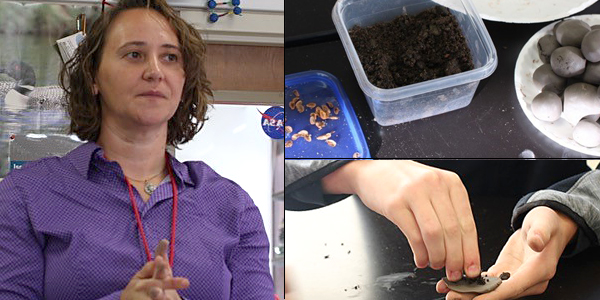
Tina Markeson, Office of Environmental Stewardship, recently talked with 11th grade biology students at Minnehaha Academy. Under Markeson’s guidance the students made over 300 seed bombs. Seed bombs are used to propagate seeds, especially in large scale areas or in poor soils. The richer soil balls give the seeds a head start and reduces the need for chemical fertilizers. Photos by Lily Mullinix, student at Minnehaha Academy |
|
 |
|

|
 |
TABLE of CONTENTS
 |
Why are we focused on Earning Customer Trust…Did we do something to lose it? |
By Tracy Hatch, deputy commissioner, chief financial officer and chief operating officer
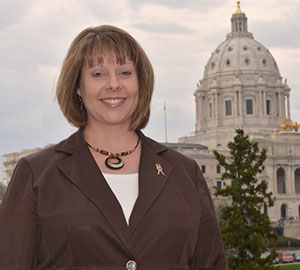
Tracy Hatch is MnDOT's deputy commissioner, chief operating officer and chief financial officer. Photo by Rich Kemp |
I frequently get questions such as: “Why is our WIG to earn customer trust? Did we do something to lose trust?” I want to share background with you on some of the forces that led MnDOT’s Senior Leadership to launch a WIG to earn customer trust.
The issue is not so much that we’ve lost customer trust, at least in terms of something MnDOT specifically did to lose trust, but rather there has been, and will continue to be, a lot of changes in the environment around us. The following is a list of areas that are different now than in the past (in no particular order):
- Political environment: There is a greater political divide among the major political parties today than in the past, which has bred criticism and skepticism from the party that does not hold the governorship toward the other party that has the governorship. We see this equally whether there is a Democrat as governor or a Republican as governor. As you know, MnDOT and all state agencies are part of the executive branch. This puts us directly in the crossfire between the political sides and therefore regardless of the truth, the political tension draws skepticism toward state agencies because we are part of the executive branch and take our direction from the governor.
- Economy/financial environment: As resources get tighter and we seek out additional resources, we draw attention to our work--which is good!--but also draw skepticism and the “prove it” types of questions. Prove you are efficient, demonstrate what you are currently doing with the resources you have--which was a part of why we took on WIG 1.0 Enhancing Financial Effectiveness. In addition, when resources are tight, all government agencies are essentially competing for the same dollars. In other words, if taxes are going to be increased, which taxes should be increased and by how much? Sales tax or income tax to the general fund to increase spending in education or human services versus gas tax or motor vehicle sales tax to fund transportation improvements. These are complex policy questions that require a trade-off between a wide variety of worthy programs and also draw deeper scrutiny over the needs and uses.
- General trust in government: In recent years the public’s general trust in government has decreased. In fact, there are numerous papers, reports and studies that talk about this. While many of the studies specifically focus on the federal government, nearly all of them also state there is a correlation, or ripple effect, between trust in the federal government and trust in state and local governments. If you’d like to do some reading on this you could certainly do a web search. There are two great resources for this, the Pew Research studies: Public Trust in Government: 1958-2015 and Beyond Distrust: How Americans View Their Government.
- Current events and the media: The WIG 2.0 framework lays out two of the areas we are hearing the most public criticism about. Namely, our engagement practices with constituent groups over the impacts of our projects on those groups and the role we are mandated to play by state or federal law, or should play in addressing issues related to equity. These are obviously hot topics in the public consciousness as well as areas where we have received a great deal of criticism over the past few years in terms of our responsibility to help advance a better quality of life for all Minnesotans. If we are not meeting the legal requirements, or if stakeholders believe we could do more to advance equitable systems within the state but do not take those steps, it has the effect of drawing criticism, skepticism and decreases trust from our stakeholders.
- Current advancements in technology and social media: As technology moves faster and social media brings more immediate responses from stakeholders (511, traffic impacts, Facebook, blogs, web content about construction project impacts, potential impacts of changes to legislation, etc.), we also see an increase in the opinions we receive from the public and stakeholders. People can almost comment in real time. Those comments, especially if they are critical of the department, can swing the opinions of others viewing the same posts, regardless of the validity of the comment. We need to remember that every post is an opportunity for us to either build trust--or lose trust--with the public and stakeholders.
|
 |
|
| |
|



